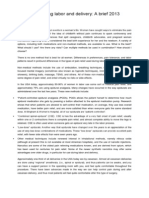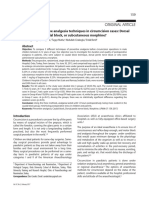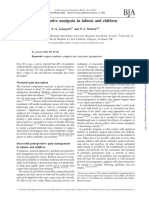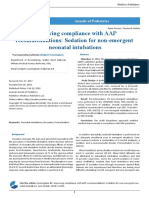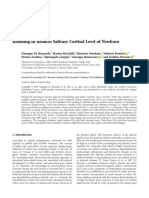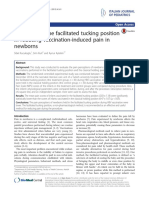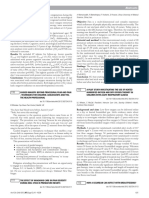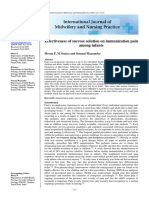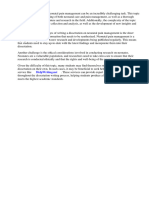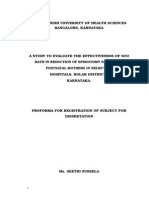Professional Documents
Culture Documents
The Effectiveness of Sucrose As A Pain Reducing Substance During Procedures in NICU
Original Title
Copyright
Available Formats
Share this document
Did you find this document useful?
Is this content inappropriate?
Report this DocumentCopyright:
Available Formats
The Effectiveness of Sucrose As A Pain Reducing Substance During Procedures in NICU
Copyright:
Available Formats
Volume 8, Issue 4, April 2023 International Journal of Innovative Science and Research Technology
ISSN No:-2456-2165
The Effectiveness of Sucrose as a Pain Reducing
Substance during Procedures in NICU
Dr. Venugopal Reddy. I. Dr. Veera Loknadha Reddy. M.
Medical Director and Consultant Paediatrician, Consultant Paediatrician and Neonatologist,
Ovum Hospital, Bangalore Bangalore.
Abstract:- The medical community has long been aware recently, metabolic screening before being released from the
of infant distress, which typically happens in a hospital hospital. The realisation that both premature and full-term
context. It has become clear that many newborns infants experience pain has brought to light the widespread
admitted to the neonatal critical care unit are not problem of newborns hospitalised in the neonatal critical
receiving enough therapy for stress and discomfort care unit being undertreated for stress and pain1. Improved
because both premature and full-term infants experience management techniques are encouraged by both scientific
pain. The use of enhanced management techniques to and humanitarian principles in order to reduce stress and
decrease stress and pain whenever possible and to offer pain whenever possible and to give timely and effective
fast and effective treatment when suffering cannot be treatment when discomfort cannot be avoided. Present-day
avoided is supported by both scientific and neonates admitted to NICUs are frequently subjected to
humanitarian reasons. At Kasturba Hospital in Manipal, noxious stimuli of varying intensities, including pain,
Karnataka, between October 2012 and September 2013, discomfort, and discomfort. These include both major and
parents of 128 term newborns who had been evaluated small surgical operations, blood draw techniques, and IV
for eligibility took part in the study after giving their cannula insertion. Pain is always a subjective experience.
informed consent. The infants were all congenitally The gold standard for evaluating pain is hence verbalization
healthy and free of abnormalities. of nociceptive sensation2.The detection and management of
pain in newborn newborns in NICUs is currently subpar
According to this study, 24% sucrose performs since neonates cannot verbalise their suffering. In the first
better than 10% dextrose as an analgesic for procedural few weeks of life, infants born at fewer than 32 weeks of
pain in term neonates. The physiological parameters of gestation are subjected to 10 to 15 unpleasant procedures
all 128 neonates were recorded, including heart rate, daily, and in approximately 80% of cases, no pain
oxygen saturation, total cry time, and pain evaluation medication is provided3.
using the NIPS score. Only 78 newborns' salivary
cortisol levels were investigated. The following criteria As in the case of protracted mechanical ventilation and
revealed no discernible differences between the 24% necrotizing enterocolitis, discomfort may be short-term or
sucrose and 10% dextrose in terms of reducing babies' long-term. Even seemingly unimportant carer duties like
procedural pain. The median total cry duration for both diaper changes, daily weighed, and tape removal provide
operations was shorter in the 24% sucrose group than in uncomfortable stimulation. All of these events have a
the 10% dextrose group. detrimental effect on long-term neurologic outcomes,
somatization disorders, and pain sensitivity, especially in
For heel lancing, 24% sucrose significantly preterm neonates. Both scientific and humanitarian
decreased discomfort in 37.5% of infants at 1 minute, considerations support the use of improved management
87.5% of neonates at 3 minutes, and 22.5 seconds vs. 130 approaches to lessen stress and pain whenever possible and
seconds for venipuncture, compared to 10% dextrose. to provide prompt and effective treatment when suffering
This implies that 24% sucrose, as opposed to 10% cannot be avoided.
dextrose, works better as an analgesic for procedural
pain in term babies. Treating pain in infants is essential for a number of
reasons, including decreased oxygenation, hemodynamic
Keywords:- New Borns, Salivary Cortisol, Sucrose, instability, and increased intracranial pressure4.For the
Dextrose, Pain. greatest benefit during unpleasant procedures, the
International Evidence-Based Group for Neonatal Pain
I. INTRODUCTION suggests combining pharmaceutical and behavioural
The length of time it took the medical establishment to therapies5. The combination of oral sucrose and a dummy
acknowledge that infants experience pain is astounding. has been shown to be the best clinically secure and effective
technique for the management of painful operations in
Everyone has the fundamental right to be pain-free, neonates. Salivary cortisol is a good predictor of the health
regardless of their size or age. Pain in newborn infants is a of the hypothalamic-pituitary-adrenal axis. Salivary cortisol
common occurrence. In the hospital setting, infants as has been evaluated in babies subjected to substantial
young as newborns frequently have uncomfortable stressful events, such as painful procedures, and is a useful
procedures. Every infant will experience iatrogenic pain in alternative to blood collection. However, other studies fell
the first few days of life, beginning with the vitamin K short of demonstrating how oral sucrose altered changes in
injection and blood testing for glucose, bilirubin, and more salivary cortisol after painful operations in newborn infants.
IJISRT23APR1015 www.ijisrt.com 1326
Volume 8, Issue 4, April 2023 International Journal of Innovative Science and Research Technology
ISSN No:-2456-2165
Therefore, more studies that pinpoint variations in salivary 520) was used to record the entire process. Salivary
cortisol are needed to explain how sucrose affects newborn cortisol was taken before and after the procedure, which is
babies. Little is known about how oral sucrose impacts the covered in more detail in the next section. Two minutes
overall physiological and behavioural stability of infants before the procedure, a 2ml syringe containing 1ml of the
undergoing traumatic procedures, despite the fact that baby solution (A or B) chosen at randomization was injected
pain is a complex issue. In the current investigation, we directly onto the anterior surface of the tongue. Infants
examined physiological (heart rate, oxygen saturation, and consumed the entire amount of sugar or dextrose solution
salivary cortisol) and behavioural (NIPS score and total cry in 45–60 seconds. Venipuncture was performed using a
time) alterations to evaluate pre and post test stress 22G needle on the hand's dorsum, and a heel lance was
responses between a normal procedure with placebo and performed using a 26G needle on the heel's posterolateral
orally administered sucrose solution. surface. The NICU's trained neonatal staff nurses
performed heel lancing, while the NICU's trained
II. MATERIALS AND METHODS residents performed venipuncture. Prior to, one and three
minutes into, and following the procedure, it was
The study was conducted at Kasturba Hospital in calculated what the hear rate, oxygen saturation, and NIPS
Manipal, Karnataka, between October 2012 and September score would be. Before and after the surgery, the total cry
2013. The study was reviewed and approved by the time was calculated. The investigator and a neonatal staff
institutional ethics committee at Manipal's Kasturba member independently evaluated each procedure's NIPS
Hospital. It had CTRI registration. Parents of 128 term score.The face expression (0, 1), cry (0-2), breathing
neonates were examined for eligibility and provided their patterns (0, 1), arms (0, 1), legs (0, 1), and level of arousal
informed permission. In total, 128 neonates were evaluated (0, 1) all contribute to the NIPS score. The overall score is
(64 in the control group and 64 in the experimental group). between 0 and 7. A score higher than three denotes pain
The infants were all congenitally healthy and free of that is clinically serious. To assess consistency among the
abnormalities. raters, an inter rater reliability analysis utilising the Kappa
III. DATA COLLECTION statistic was carried out. It was discovered that the raters'
inter-rater reliability was Kappa = 0.584 (p 0.05), 95% CI
The validity of pain assessment in newborn infants (0.485, 0.685). This suggests that the two observers are in
was improved by examining physiological and behavioural moderate agreement. For the final analysis, the
pain indicators. Data were collected during heel lancing and investigator's NIPS score was used.
venipuncture procedures carried out as part of regular Saliva collection for cortisol estimation: A cotton swab
clinical treatment for the calculation of glucose and that is rolled at one end and measures 10 cm in length. It
bilirubin, as well as for thyroid function tests, respectively. is sterilised by autoclaving in CSSD and delivered in
The newborns in the control group (n=64) received 10% sterile packets (Figs. 3 and 4). To prevent unintentional
dextrose. A 24% sucrose solution was used by the choking, the neonate's cotton swab was held underneath
experimental group. the tongue for 20 minutes while being closely watched.
Randomization: The hospital pharmacy provided the Each neonate had two samples taken: one baseline sample
NICU with the test solution (24% sucrose) and the before the surgery and the other sample thereafter, which
placebo solution (10% dextrose) during the trial in was taken at the peak cortisol release time of 20
identical bottles without labels but with the codes A and minutes.No baby cried or displayed any signs of pain
B. Only after the study's conclusion were the codes made during the saliva collection because it was done in a quiet
public. By adopting computer-generated blocked setting. After saliva collection, a sterile medical blade was
randomization, it was possible to conceal allocation while used to cut the cotton swab away from the wooden shaft.
keeping observers' eyes open.The investigator used Using a syringe technique, saliva from the cotton swab
randomization to determine the solution to be was collected and placed in a simple (red) micro
administered to a certain neonate right before performing vacutainer (Figs. 5 and 6). The samples were kept in the
the surgery. biochemistry lab's cold storage at -70 degrees Celsius. In
Procedure: All operations were carried out as needed the biochemistry lab, salivary cortisol was determined in
when there was a clinical need because cortisol doesn't all of the samples using an ELISA kit (DRG Salivary
have a diurnal rhythm throughout the neonatal period. cortisol HS ELISA kit, SLV-4635, Germany). The
Everything was done one hour after the meal. The amount of cortisol in the saliva was measured in ng/ml.
neonate's wrist was attached to a pulse oxymeter (Philips The normal reference range for salivary cortisol is 3.4–
vital signs MP 20) monitor to record the pulse rate and 23.45 ng/ml, with a mean and standard deviation of
oxygen saturation with the least amount of disruption to 10.71–6.58 ng/ml75.
the baby's routine. A cellphone camera (Nokia Lumia
IJISRT23APR1015 www.ijisrt.com 1327
Volume 8, Issue 4, April 2023 International Journal of Innovative Science and Research Technology
ISSN No:-2456-2165
Fig. 1: Sterile cotton swab rolled on a thin wooden stick
Fig. 2: sterile cotton swabs in a sterile packet
Fig. 3: saliva extraction step 1 Fig 4: saliva extraction step 2
IJISRT23APR1015 www.ijisrt.com 1328
Volume 8, Issue 4, April 2023 International Journal of Innovative Science and Research Technology
ISSN No:-2456-2165
Statistical Analysis: The statistical analyses were carried groups using the Mann-Whitney U test. Based on NIPS
out using SPSS for Windows (version 16.0, SPSS Inc, scores, the samples were divided into two groups: less
Chicago, IL, USA). To compare demographic traits, the than 4 and greater than or equal to 4 because a score of 4
mean, standard deviation, frequency, independent t-test denotes clinically severe pain. The proportions of these
for continuous data, and 2 test for categorical data were all values at 1 and 3 minutes following surgery were
employed. The differences in heart rate, oxygen compared using the Fisher exact test.
saturation, and salivary cortisol % were assessed before Codes are revealed: The principal chemist released the
the procedure, after it started, and three minutes codes following the investigation and analysis.
afterwards. The Mann-Whitney U test was used to Code A = 10% Dextrose
compare these numbers between the two groups. Cry Code B = 24% Sucrose
length and NIPS Score were compared between the two
Assessed for eligibility (n=160)
Enrollment
Excluded (n=32)
-Parents refused to give
Consent
Randomization
Randomized (n=128)
Allocation
Allocated to 10% Dextrose group Allocated to 24% Sucrose group (n=64)
(n=64)
Received solution B (n=64)
Received solution A (n=64)
Analysis
Analyzed (n=64) Analyzed (n=64)
Venipuncture (n=32) Venipuncture (n=32)
Heel prick (n = 32) Heel prick (n = 32)
Fig. 5: Consort flow diagram
IV. RESULTS AND DISCUSSION NIPS score
Crying behavior:
The results were interpreted between the experimental Total cry time
and control groups with the following parameters.
Demographic characteristics There were 128 neonates randomly assigned, 64 to
Physiological parameters: each group. All 128 neonates had their physiological
Heart rate measurements taken, including heart rate, oxygen saturation,
Oxygen saturation total cry time, and pain assessment using the NIPS score.
Biochemical parameters: However, because there were insufficient samples, salivary
Salivary cortisol cortisol was only examined in 78 neonates. The findings and
Pain Assessment: discussion are listed below.
IJISRT23APR1015 www.ijisrt.com 1329
Volume 8, Issue 4, April 2023 International Journal of Innovative Science and Research Technology
ISSN No:-2456-2165
A. DEMOGRAPHIC CHARACTERISTICS
Table 1: Demographic characteristics
10% Dextrose 24% Sucrose
Variable p value*
(n=64) (n=64)
Gender (male/female) 32/32 33/31 0.860
Birth weight(gm) 2955 ± 435 2826 ± 514 0.213
Gestational age(weeks) 38.2 ± 1.0 38.1 ± 1.0 0.732
Postnatal age (hours) 69.0 ± 46.5 68.4 ± 38.5 0.105
Mode of delivery(VD/LSCS) 17/47 23/41 0.253
Apgar score at 5 min 9 9
2
Data are expressed as number or mean ± SD (standard
χ test for categorical data.
deviation)
The experimental group and the control group did not
*
p value corresponds to results of independent t-test differ significantly in any of the demographic variables.
for continuous data and
B. PHYSIOLOGICAL PARAMETERS
HEART RATE(HR) BEFORE AND DURING THE PROCEDURE:
Table 2: Comparison of heart ratebefore and during the procedures between the groups
Procedure Solution HR before HR at *p value HR *p value
received procedureMean t=1minMean att=3minMean
± SD ± SD ± SD
Heel lance 10% Dextrose 138 ± 14 142 ± 17 0.327 137 ± 19 0.626
(n=64) (n=32)
24% Sucrose 140 ± 12 148 ± 16 138 ± 23
(n=32)
Venipuncture 10% 133 ± 13 146 ± 22 0.340 148 ± 26 0.155
(n=64) Dextrose(n=32)
24% 133 ± 15 149 ± 18 139 ± 28
Sucrose(n=32)
*p value corresponds to Mann-Whitney U test Heart rate expressed as beats per minute.
Heel lance: The mean heart rate rose in both groups one Succrose considerably decreased heart rate as
minute after the heel lance procedure, but it fell three compared to the control group (sterile water) in numerous
minutes later. The heel lance's exceptionally quick-acting previous experiments conducted by Bucher HU et al.80,
discomfort, which for most babies lasts between 30 and a Ramenghi LA et al., and Ors R et al.
minute, is the cause of this disparity. The heart rates were
similar in both groups. The percentage differences Venipuncture: At one minute after the procedure, the
between the heart rates prior to surgery and at 1 and 3 mean heart rate in both groups increased during the
minutes following it were calculated using the Mann- venipuncture technique. However, the heart rate in the
Whitney U test. There were no statistically significant 24% sucrose group is lower after 3 minutes after the
differences in heart rate between 24% sucrose and 10% surgery, while it is higher in the 10% dextrose group. This
dextrose for the heel lance procedure. discrepancy results from the pain, which lasts for two to
three minutes. It is likely that sucrose reduced the pain
There were no discernible variations in heart rate and, as a result, the heart rate three minutes after the
between the sucrose group and the control group (sterile treatment. We used the Mann-Whitney U test to calculate
water or no treatment) in the trials conducted by Kyounget the percentage differences between the heart rates before
al. and Isik U et al. the procedure and at 1 and 3 minutes after it. According to
statistics, there were no appreciable variations in heart rate
IJISRT23APR1015 www.ijisrt.com 1330
Volume 8, Issue 4, April 2023 International Journal of Innovative Science and Research Technology
ISSN No:-2456-2165
during venipuncture between 24% sucrose and 10% In studies by Abad et al, Acharya et al, sucrose
dextrose. significantly reduced heart rate compared to control group.
OXYGEN SATURATION (SpO2) BEFORE AND DURING THE PROCEDURE:
Table 3: Comparison of oxygen saturation before and during the procedures between the groups.
Procedure Solution SpO2 before SpO2 at * p value SpO2 att=3 *P value
received procedureMean t=1minMean ± minMean ±
± SD SD SD
Heel lance(n=64) 10% 98.3 ± 2 95.4 ± 4.3 0.543 95.5±5.3 0.253
Dextrose(n=32)
24% 97.8± 2.3 95.6 ± 4.1 96.2±4.4
Sucrose(n=32)
Venipuncture(n=64) 10% 97.7± 2.2 93.0± 7.0 0.727 93.0±6.0 0.535
Dextrose(n=32)
24% 98.0 ± 1.8 94.0± 7.2 94.3±8.3
Sucrose(n=32)
*P value Mann-Whitney U test
Heel lance: For heel lance, there were no appreciable Venipuncture: For venipuncture, there were no
changes in the means of oxygen saturation between 24% appreciable variations in oxygen saturation between 24%
sucrose and 10% dextrose. We used the Mann-Whitney U sucrose and 10% dextrose. We used the Mann-Whitney U
test to calculate the percentage differences between the test to calculate the percentage differences between the
SpO2 levels prior to the surgery and at 1 and 3 minutes SpO2 levels prior to the surgery and at 1 and 3 minutes
after it. In terms of SPO2 for the heel lance operation, after it. Statistics revealed no significant variations in
there were no statistically significant changes between SpO2 during venipuncture between 24% sucrose and 10%
24% sucrose and 10% dextrose. dextrose.
There were no appreciable variations in SpO2 between There were no discernible variations in SpO2 between
the sucrose group and the control groups in the the sucrose and control groups in the research by Rush et al.
investigations by Overgaard C et al., Harrison D et al, (1992), Yilmaz F et al. (1993), and Ogawa S et al. (1994).
Mathai S, and Okan F.
There are no studies that demonstrate appreciable
There was a considerable drop in SpO2 in the sucrose variations in oxygen saturation between the sucrose group
group compared to breast feeding group, according to a and the control group during venipuncture.
study by Codipeitro et al.11.
C. BIOCHEMICAL PARAMETERS
SALIVARY CORTISOL BEFORE AND AFTER THE PROCEDURE
Table 4: Comparison of salivary cortisol before and after the procedures between the groups
Procedure Solution Salivary cortisol before Salivary cortisol after *p value
received procedure procedure
Mean ± SD Mean ± SD
Heel lance 10% Dextrose 18.1 ± 9.0 20.1 ± 8.3 0.820
(n=40) (n=20)
24% Sucrose 14.1 ± 8.6 17.3 ± 9.8
(n=20)
Venipuncture 10% Dextrose 16.4 ± 8.4 17.9 ± 7.4 0.593
(n=38) (n=20)
24% Sucrose 14.1 ± 9.2 15.5 ± 9.6
(n=18)
*p value corresponds to Mann-Whitney U test
IJISRT23APR1015 www.ijisrt.com 1331
Volume 8, Issue 4, April 2023 International Journal of Innovative Science and Research Technology
ISSN No:-2456-2165
Heel lance: There were no discernible differences Studies that evaluated the salivary cortisol levels
between the salivary cortisol levels assessed before and between the sucrose group and the control group using 10%
after the heel lance operation using 24% sucrose and 10% dextrose for the heel lance found no discernible differences.
dextrose. The percentage differences in salivary cortisol
levels before and after the operation were calculated using Salivary cortisol levels before and after venipuncture
the Mann-Whitney U test. For the heel lance method, in the presence of 24% sucrose and 10% dextrose did not
there were no statistically significant differences in differ substantially. The percentage differences in salivary
salivary cortisol levels between 24% sucrose and 10% cortisol levels before and after the operation were calculated
dextrose. using the Mann-Whitney U test. There were no statistically
significant differences between 24% sucrose and 10%
In two studies by Kyoung et al.56 and Greenberg et dextrose in terms of SPO2 for the heel lance procedure.
al.95, there were no observable differences between the two Salivary cortisol levels during venipuncture have not been
groups. studied.
D. PAIN ASSESSMENT
NIPS SCORES BEFORE AND DURING THE PROCEDURES
Table 5: Comparison of NIPS score at 1 min and 3 min after procedure between the groups
NIPS at NIPS at
Solution
Procedure t=1 min *p value t=3min *p value
received
Median(Q1,Q3) Median(Q1,Q3)
10% Dextrose
7(3,7) 0(0,3.7)
(n=32)
0.
Heel lance(n=64) 0.814
059
24% Sucrose
7(2,7) 0(0,0)
(n=32)
10% Dextrose
7(5,7) 6(0,7)
(n=32)
Venipuncture 0.
0.102
(n=64) 190
24% Sucrose
7(2,7) 1(0,7)
(n=32)
*p value corresponds to Mann – Whitney U test
Fig. 6: Box plot showing Median NIPS scores at 1 min and at 3 min for Heel lance. The line inside the box represents the median
NIPS score and the colored area represents the inter quartile range
IJISRT23APR1015 www.ijisrt.com 1332
Volume 8, Issue 4, April 2023 International Journal of Innovative Science and Research Technology
ISSN No:-2456-2165
X axis: Solution received ; Y axis: NIPS score, Heel lance: The 24% sucrose and 10% dextrose groups
Procedure: Heel lance did not significantly vary in NIPS scores at 1 or 3
minutes.
Blue: NIPS score at 3 minutes post procedure
Green:NIPS score at 3 minutes post procedure There was a substantial decline in NIPS scores for the
sucrose group in studies by Kyong et al.16, Overgaard et
al.27, and Yilmaz et al.33 as compared to the control group.
Fig. 7: Box plot showing Median NIPS scores at 1 min and at 3 min for venipuncture. The line inside the box represents the
median NIPS score and the colored area represents the inter quartile range
X axis: Solution received ; Y axis: NIPS score, score at 3 minutes for the 10% dextrose group was 6 and
Procedure: Heel lance the median NIPS score for the 24% sucrose group was 1.
This shows that 3 minutes after the surgery, 24% sucrose
Blue: NIPS score at 3 minutes post procedure is effective in reducing discomfort. The groups did not,
however, vary statistically significantly. No studies
Green:NIPS score at 3 minutes post procedure employing the NIPS score for venipuncture have been
published.
Venipuncture: While the median NIPS scores at 1 and 3
minutes were similar for both groups, the median NIPS
Table 6: Comparison between the 10% Dextrose and 24% Sucrose groups for the number of newborns with an NIPS score of 4 at
1 minute and 3 minutes following the procedure.
NIPS score<4 at t=1min NIPS score<4 at t=3min
10% 24% Sucrose 10% 24% Sucrose *
Procedure Dextrose(n=32) (n=32) *p value Dextrose(n=32) (n=32) p value
Heel lance(n=32) 9 12 0.595 24 28 0.337
Venipuncture
(n=32) 5 12 0.088 14 21 0.131
*p value corresponds to Fischer Exact test.
At 1 and 3 minutes into the procedure, there were 10% dextrose. However, when the Fischer exact test was
more infants who received sucrose and received an NIPS employed to compare the groups, there were no statistically
score of 4 than there were when 10% dextrose was utilised. significant differences between 24% sucrose and 10%
Therefore, 24% sucrose has a better analgesic impact than dextrose.
IJISRT23APR1015 www.ijisrt.com 1333
Volume 8, Issue 4, April 2023 International Journal of Innovative Science and Research Technology
ISSN No:-2456-2165
E. CRYING BEHAVIOR
TOTAL CRY TIME DURING THE PROCEDURE:
Table 7: Comparison of Total cry time during procedure between 10% Dextrose and 24% Sucrose groups
Procedure Total Cry Time during procedure (in seconds) *p value
10% Dextrose 24% Sucrose
(n=64) (n=64)
Median(Q1Q3) Median(Q1Q3)
Heel lance(n=64) 37.5(2.7,63.7) 10(0,54) 0.16
Venipuncture 130(18.7,180) 22.5(0,180) 0.11
(n=64)
*p value corresponds to Mann-Whitney U test.
Fig. 8: Box plot showing Median Total cry time for both the groups for heel lance procedure
Heel lance: When compared to the dextrose group, the that sucrose reduced the amount of time babies spent crying
sucrose group's total cry time was much lower (median 10 overall compared to the control group. In other
sec). However, statistically speaking, there was no investigations by Harrison et al.88, Mathai et al.29, and
change. Ogawa et al.34, the sucrose group's cry time was not
significantly shorter than that of the control group.
Researchers Kyoung et al.16, Isik U et al.19, Bucher
HU et al.80, Ramenghi LA et al.11, and Ors R et al.12 found
Fig. 9: Box plot showing Median Total cry time for both the groups for venipuncture procedure
IJISRT23APR1015 www.ijisrt.com 1334
Volume 8, Issue 4, April 2023 International Journal of Innovative Science and Research Technology
ISSN No:-2456-2165
Venipuncture: When compared to the dextrose group procedures.Cochrane Database Syst Rev. 2013 Jan
(median 130 sec), the sucrose group's total cry time was 31;1:CD001069. doi:
significantly lower (22.5 sec on average). However, 10.1002/14651858.CD001069.pub4.
statistically speaking, there was no change. [6.] Finnström O, Schollin J. [Newborn infants do feel
pain! Technique and environment in connection with
In investigations by Acharya et al.26 and Abad et specimen collection can be improved].
al.25, sucrose decreased the amount of sobbing. In a study Lakartidningen. 1998 Dec 9; 95(50):5718–20.
by Ogawa et al. (1994), the sucrose group's cry time was not [7.] Anand KJ, Craig KD. New perspectives on
significantly shorter than that of the control groups. thedefinition of pain. Pain. 1996;67(1):3–6;discussion
209-211.
V. CONCLUSION [8.] Anand KJ, Scalzo FM. Can adverse
neonatalexperiences alter brain development and
When it came to reducing neonates' procedural
subsequentbehavior? Biol. Neonate. 2000
discomfort, there were no discernible differences between
Feb;77(2):69–82.
the 24% sucrose and 10% dextrose treatments, according
[9.] Lonnie K, Zeltzer and Elliot J Krane. Pediatric Pain
to the following criteria.
Management. In: Kliegman, Stanton, St.Geme, Schor,
Included are heart rate, SpO2, total cry time, NIPS score, Behrman, editors. Nelson Textbook of
and salivary cortisol. Paediatrics.19thed. New Delhi: Reed Elsevier India
For both procedures, the median total cry duration was private Limited; 2012. p. 360-361.
shorter in the 24% sucrose group compared to the 10% [10.] Johnston CC, Collinge JM, Henderson SJ, Anand
dextrose group (10 seconds for heel lancing and 22.5 KJ.A cross-sectional survey of pain and
seconds for venipuncture, respectively). pharmacological analgesia in Canadian neonatal
Compared to 10% dextrose, which only marginally intensive care units. Clin J Pain. 1997
(NIPS4) decreased pain in 37.5% of infants at 1 minute Dec;13(4):308–12.
and 87.5% of neonates at 3 minutes for heel lance, 24% [11.] Grunau R. Early pain in preterm infants. A model
sucrose markedly (NIPS4) decreased pain in these oflong-term effects. Clin Perinatol. 2002
neonates. Sep;29(3):373–394.vii-viii.
Neonates' pain was greatly reduced by 24% sucrose [12.] Anand KJ. Clinical importance of pain and stress
(NIPS4) compared to 10% dextrose, which had only a inpreterm neonates. Biol. Neonate. 1998;73(1):1–9.
minor (15.6%) and significant (43.8%) pain reduction for [13.] Gleiss J, Stuttgen G. Morphologic and
venipuncture in 37.5% newborns at 1 min and 65.6% functionaldevelopment of the skin. In: Stave U (ed.)
neonates at 3 min. Physiology of the perinatal period . Vol. 2. New
As a result, we may conclude that in clinical praxis, 24% York: Appleton-Century Crofts, 1970:889-906.
sucrose performs better than 10% dextrose as an analgesic [14.] Tilney F, Rosett J. The value of brain lipids as
for procedural pain in term babies. anindex of brain development. Bull Neurol Inst NY.
Salivary cortisol can be used to quantify neonatal stress 1931; 1:28-71.
non-invasively, and the method used in this investigation [15.] Schulte FJ. Neurophysiological aspects of
to collect saliva resulted in an adequate number of braindevelopment. Mead Johnson Symp Perinat Dev
samples that were equivalent to those from other studies. Med 1975; 6:38-47.
[16.] Gilles FJ, Shankle W, Dooling EC. Myelinated
REFERENCES tracts:growth patterns. In: Gilles FH, Leviton A,
Dooling EC, eds. The developing human brain:
[1.] Carol Spruill Turnage, Michelle A, LaBercque.
growth and epidemiologic neuropathology. Boston:
Preventing and treating pain and stress among infants
John Wright,1983: 117-83.
in the newborn intensive care unit. In: John
[17.] Slater R, Cantarella A, Gallella S, Worley A, Boyd
P.Cloherty, Eric C.Eichenwald, Anne R.Hansen, Ann
S,Meek J, et al. Cortical pain responses in human
R.Stark, editors. Manual of Neonatal Care. 7thed.
infants. J. Neurosci. 2006 Apr 5;26(14):3662–6.
New Delhi: Wolters Kluver (India) Pvt Ltd;
[18.] Bartocci M, Bergqvist LL, Lagercrantz H, Anand
2012.p.870-871.
KJS.Pain activates cortical areas in the preterm
[2.] Pain terms: a list with definitions and notes on usage.
newborn brain. Pain. 2006 May;122(1-2):109–17.
Recommended by the IASP Subcommittee on
[19.] Wong CM, Boyle EM, Stephen RI, Smith J,
Taxonomy. Pain.1979;6(3):249-252.
StensonBJ, McIntosh N, et al. Normative values of
[3.] Stevens B, McGrath P, Gibbins S, et al. Procedural
substance P and neurokinin A in neonates. Ann. Clin.
pain in newborns at risk for neurology impairment.
Biochem.2010 Jul;47(Pt 4):331–5.
Pain. 2003 Sep; 105(1–2):27-35.
[20.] Taddio A, Shah V, Shah P, Katz J. Beta-
[4.] Anand KJ. International Evidence-Based Group for
endorphinconcentration after administration of
Neonatal Pain. Consensus statement for the
sucrose in preterm infants. Arch Pediatr Adolesc
prevention and management of pain in the
Med. 2003 Nov;157(11):1071–4.
newborn. Arch Pediatr Adolesc Med. 2001
[21.] Friesen RH, Honda AT, Thieme RE. Changes
Feb;155(2):173–180.
inanterior fontanel pressure in preterm neonates
[5.] Stevens B, Yamada J, Ohlsson A. Sucrose for
analgesia in newborn infants undergoing painful
IJISRT23APR1015 www.ijisrt.com 1335
Volume 8, Issue 4, April 2023 International Journal of Innovative Science and Research Technology
ISSN No:-2456-2165
during tracheal intubation. Anesth. Analg. 1987 [35.] South MMT, Strauss RA, South AP, Boggess
Sep;66(9):874–8. JF,Thorp JM. The use of non-nutritive sucking to
[22.] Hickey PR, Hansen DD, Wessel DL, Lang P, Jonas decrease the physiologic pain response during
RA,Elixson EM. Blunting of stress responses in the neonatal circumcision: a randomized controlled
pulmonary circulation of infants by fentanyl. Anesth. trial.Am. J. Obstet. Gynecol. 2005 Aug;193(2):537–
Analg. 1985 Dec;64(12):1137–42. 542;discussion 542–543.
[23.] Greisen G, Frederiksen PS, Hertel J, Christensen
NJ.Catecholamine response to chest physiotherapy
and endotracheal suctioning in preterm infants. Acta
Paediatr Scand. 1985 Jul;74(4):525–9.
[24.] Anand KJ, Hall RW, Desai N, Shephard B, Bergqvist
LL, Young TE, Boyle EM, Carbajal R, Bhutani VK,
Moore MB, Kronsberg SS, Barton BA: Effects of
morphine analgesia in ventilated preterm neonates:
primary outcomes from the NEOPAIN randomised
trial. Lancet. 2004 May 22;363(9422):1673-82.
[25.] Gallo AM. The fifth vital sign: implementation of the
Neonatal Infant Pain Scale.J Obstet Gynecol
Neonatal Nurs. 2003 Mar-Apr;32(2):199-206.
[26.] Carol Spruill Turnage , Michelle A, LaBercque.
Preventing and treating pain and stress among infants
in the newborn intensive care unit. In: John
P.Cloherty, Eric C.Eichenwald, Anne R.Hansen, Ann
R.Stark, editors. Manual of Neonatal Care. 7th ed.
New Delhi: Wolters Kluver(India) Pvt Ltd; 2012. p.
874.
[27.] Stevens B, Johnston C, Petryshen P, Taddio A.
Premature infant pain profile: development and initial
validation. Clin J Pain. 1996 Mar;12(1):13–22.
[28.] Lawrence J, Alcock D, McGrath P, Kay J,
MacMurraySB, Dulberg C. The development of a
tool to assess neonatal pain. Neonatal Netw. 1993
Sep;12(6):59–66.
[29.] Craig KD, Hadjistavropoulos HD, Grunau
RVE,Whitfield MF. A comparison of two measures
of facial activity during pain in the newborn child. J.
Pediatr. Psychol. 1994 Jan 6;19(3):305–18.
[30.] Hummel P, Puchalski M, Creech SD, Weiss
MG.Clinical reliability and validity of the N-PASS:
neonatal pain, agitation and sedation scale with
prolonged pain. J Perinatol. 2008 Jan;28(1):55–60.
[31.] Krechel SW, Bildner J. CRIES: a new
neonatalpostoperative pain measurement score. Initial
testing of validity and reliability. Paediatr
Anaesth.1995;5(1):53–61.
[32.] Ambuel B, Hamlett KW, Marx CM, Blumer
JL.Assessing distress in pediatric intensive care
environments: the COMFORT scale. J Pediatr
Psychol. 1992 Feb;17(1):95–109.
[33.] American Academy of Pediatrics Committee on Fetus
and Newborn; American Academy of Pediatrics
Section on Surgery; Canadian Paediatric Society
Fetus and Newborn Committee, Batton DG,
Barrington KJ, Wallman C.Prevention and
management of pain in the neonate: an
update.Pediatrics. 2006 Nov;118(5):2231-41.
[34.] Anand KJS, Aranda JV, Berde CB, Buckman
S,Capparelli EV, Carlo W, et al. Summary
proceedings from the neonatal pain-control group.
Pediatrics.2006 Mar;117(3 Pt 2):S9–S22.
IJISRT23APR1015 www.ijisrt.com 1336
You might also like
- Influence of repeated procedures and sucrose on hyperalgesia in newbornsDocument6 pagesInfluence of repeated procedures and sucrose on hyperalgesia in newbornsannagm97No ratings yet
- Journal Homepage: - : Manuscript HistoryDocument46 pagesJournal Homepage: - : Manuscript HistoryIJAR JOURNALNo ratings yet
- Harrison Prevention and Management of Pain and Stress in The Neonate 2015Document8 pagesHarrison Prevention and Management of Pain and Stress in The Neonate 2015Sasha Hidayat FullNo ratings yet
- Pain Relief During Labor and Delivery: A Brief 2013 UpdateDocument5 pagesPain Relief During Labor and Delivery: A Brief 2013 UpdateJheiczhietoot KibasNo ratings yet
- The Effect of Preoperative Fasting To Postoperative NauseaDocument7 pagesThe Effect of Preoperative Fasting To Postoperative NauseasantiNo ratings yet
- Neonatal Procedural Pain Exposure and Pain Management in Ventilated Preterm Infants During The First 14 Days of LifeDocument7 pagesNeonatal Procedural Pain Exposure and Pain Management in Ventilated Preterm Infants During The First 14 Days of LifePaula Andrea Beltran RamirezNo ratings yet
- Sedacion en Ventilación Mecánica NeonatalDocument31 pagesSedacion en Ventilación Mecánica NeonatalJorge CastroNo ratings yet
- Blood Sampling in Infants (Reducing Pain and Morbidity) : Olga KapellouDocument18 pagesBlood Sampling in Infants (Reducing Pain and Morbidity) : Olga KapelloumustafasacarNo ratings yet
- Original Article September-December, 2016/vol 36/issue 3: Singh RK, Simalti AK, Singh DDocument5 pagesOriginal Article September-December, 2016/vol 36/issue 3: Singh RK, Simalti AK, Singh DAnjaliNo ratings yet
- Manajemen NyeriDocument8 pagesManajemen Nyeriagung yulisaputraNo ratings yet
- Complementary Therapies in Medicine: SciencedirectDocument6 pagesComplementary Therapies in Medicine: SciencedirectSurya Puji KusumaNo ratings yet
- Villanueva Poster FinalDocument1 pageVillanueva Poster FinaljcposhNo ratings yet
- Effectiveness of Prone vs. Supine Position on Respiratory Patterns in NeonatesDocument4 pagesEffectiveness of Prone vs. Supine Position on Respiratory Patterns in NeonatesLaelannie MagpayoNo ratings yet
- Sedation and Analgesia in Children Undergoing Invasive ProceduresDocument7 pagesSedation and Analgesia in Children Undergoing Invasive ProceduresSantosa TandiNo ratings yet
- Comparison of Preventive Analgesia Techniques in Circumcision Cases Dorsal Penile Nerve Block, Caudal Block, or Subcutaneous MorphineDocument7 pagesComparison of Preventive Analgesia Techniques in Circumcision Cases Dorsal Penile Nerve Block, Caudal Block, or Subcutaneous MorphinenatamkpNo ratings yet
- Baby Massage Ameliorates Neonatal Jaundice in Full-Term Newborn InfantsDocument6 pagesBaby Massage Ameliorates Neonatal Jaundice in Full-Term Newborn Infantsgladeva yugi antariNo ratings yet
- 1 s2.0 S0020748914000777 MainDocument10 pages1 s2.0 S0020748914000777 MainPablo GonzálezNo ratings yet
- Postoperative Analgesia in Infants and Children: P.-A. Lo Nnqvist and N. S. MortonDocument10 pagesPostoperative Analgesia in Infants and Children: P.-A. Lo Nnqvist and N. S. MortonT RonaskyNo ratings yet
- Endoscopy in Pediatric Inflammatory Bowel DiseaseFrom EverandEndoscopy in Pediatric Inflammatory Bowel DiseaseLuigi Dall'OglioNo ratings yet
- BBLR 2Document6 pagesBBLR 2refiNo ratings yet
- PainDocument9 pagesPainRinda KurniawatiNo ratings yet
- To Assess The Effectiveness of Oral Sucrose Solution On Pain Perception Among Infants Receiving Immunization in Selected Pediatric Units at Indore.Document7 pagesTo Assess The Effectiveness of Oral Sucrose Solution On Pain Perception Among Infants Receiving Immunization in Selected Pediatric Units at Indore.IJAR JOURNALNo ratings yet
- Postoperative Analgesia in Infants and Children: P.-A. Lo Nnqvist and N. S. MortonDocument10 pagesPostoperative Analgesia in Infants and Children: P.-A. Lo Nnqvist and N. S. MortonMega SudibiaNo ratings yet
- The Role of Delayed Cord Clamping in Improving The Outcome in Preterm BabiesDocument5 pagesThe Role of Delayed Cord Clamping in Improving The Outcome in Preterm BabiesJehangir AllamNo ratings yet
- Baik Schneditz2018Document13 pagesBaik Schneditz2018Ana LyaNo ratings yet
- 1 s2.0 S0378378216305813 MainDocument8 pages1 s2.0 S0378378216305813 MainPablo GonzálezNo ratings yet
- Pediatrics 1001 (Final)Document5 pagesPediatrics 1001 (Final)Paul HartingNo ratings yet
- International Consensus On Cardiopulmonary Resuscitation and Emergency Cardiovascular Care Science With Treatment Recommendations (Costr)Document71 pagesInternational Consensus On Cardiopulmonary Resuscitation and Emergency Cardiovascular Care Science With Treatment Recommendations (Costr)Dr.Sushree Smita BehuraNo ratings yet
- Evidence Based Practices For The Fetal TDocument11 pagesEvidence Based Practices For The Fetal TYena KartinaNo ratings yet
- NICU Pain Management: Anesthesia, Analgesia, and AssessmentDocument19 pagesNICU Pain Management: Anesthesia, Analgesia, and AssessmentPaulHerreraNo ratings yet
- Mi2018 2845352 PDFDocument5 pagesMi2018 2845352 PDFDewi LarasatiNo ratings yet
- 56 1-Gunay Original 10 2Document9 pages56 1-Gunay Original 10 2Mbah AbuNo ratings yet
- The Effect of The Facilitated Tucking Position in Reducing Vaccination-Induced Pain in NewbornsDocument7 pagesThe Effect of The Facilitated Tucking Position in Reducing Vaccination-Induced Pain in NewbornsCassanovaNovaNo ratings yet
- Lung Ultrasound Score As A Predictor of Ventilator Use in Preterm Infants With Dyspnea Within 24 H After Dhospitalization PDFDocument8 pagesLung Ultrasound Score As A Predictor of Ventilator Use in Preterm Infants With Dyspnea Within 24 H After Dhospitalization PDFcesar juarezNo ratings yet
- Eview Article: Pain Relief in NeonatesDocument9 pagesEview Article: Pain Relief in NeonatesresidenanakNo ratings yet
- A Prospective Audit of Pain Profiles Following General and Urological Surgery in ChildrenDocument10 pagesA Prospective Audit of Pain Profiles Following General and Urological Surgery in ChildrenLakhwinder KaurNo ratings yet
- Breastfeeding Is Analgesic in Healthy Newborns: ContextDocument6 pagesBreastfeeding Is Analgesic in Healthy Newborns: ContextSigit AndriantoNo ratings yet
- Artikel 1 Pandita 2018Document5 pagesArtikel 1 Pandita 2018Eline DebaereNo ratings yet
- Postoperative Analgesia in Infants and Children: P.-A. Lo Nnqvist and N. S. MortonDocument10 pagesPostoperative Analgesia in Infants and Children: P.-A. Lo Nnqvist and N. S. MortonFikran SiddikNo ratings yet
- Managing Pain in ChildrenDocument19 pagesManaging Pain in ChildrensyarifaNo ratings yet
- Sciences, Shiraz, Iran: AbstractsDocument1 pageSciences, Shiraz, Iran: AbstractspermanaNo ratings yet
- Ring Block Improves Analgesia For Newborn CircumcisionDocument7 pagesRing Block Improves Analgesia For Newborn Circumcisioneiad-mahmoudNo ratings yet
- Ortho - PediaDocument6 pagesOrtho - PediaKayeNo ratings yet
- Jurnal AnestesiDocument8 pagesJurnal AnestesiapriiiiiiilllNo ratings yet
- Jerrold Lerman - Neonatal Anesthesia-Springer (2023)Document653 pagesJerrold Lerman - Neonatal Anesthesia-Springer (2023)Leo YueNo ratings yet
- Skin To SkinDocument9 pagesSkin To SkinAsiatiNo ratings yet
- Effects of Breastfeeding in Conjunction With The Skin-to-Skin Contact Method During Calcaneus PunctureDocument6 pagesEffects of Breastfeeding in Conjunction With The Skin-to-Skin Contact Method During Calcaneus PunctureIJAERS JOURNALNo ratings yet
- Practical Approaches To Sedation and Analgesia in The NewbornDocument13 pagesPractical Approaches To Sedation and Analgesia in The NewbornRiskiNo ratings yet
- Journal Homepage: - : IntroductionDocument10 pagesJournal Homepage: - : IntroductionIJAR JOURNALNo ratings yet
- Bagus 2020Document3 pagesBagus 2020Atikah AbayNo ratings yet
- Neonatal Pain Management DissertationDocument8 pagesNeonatal Pain Management DissertationWillSomeoneWriteMyPaperForMeNorman100% (1)
- Manejo Del Dolor en RNDocument30 pagesManejo Del Dolor en RNtadessetogaNo ratings yet
- 0 Aet484Document7 pages0 Aet484UsbahNo ratings yet
- Epidemiology and Treatment of Painful Procedures in Neonates in Intensive Care UnitsDocument13 pagesEpidemiology and Treatment of Painful Procedures in Neonates in Intensive Care UnitsmustafasacarNo ratings yet
- Labour Pain Management With Water Immersion: The West Indian Medical Journal April 2016Document7 pagesLabour Pain Management With Water Immersion: The West Indian Medical Journal April 2016rositaNo ratings yet
- 238 FullDocument10 pages238 FullJorge CastroNo ratings yet
- 334 EnglishDocument7 pages334 EnglishkhalidNo ratings yet
- 05 N006 5660Document24 pages05 N006 5660DeepaRamaniNo ratings yet
- The Effect and Implication of Developmental Supportive Care Practices in Preterm BabiesDocument23 pagesThe Effect and Implication of Developmental Supportive Care Practices in Preterm BabiesInternational Journal of Innovative Science and Research Technology100% (1)
- Anaesthetic Consideration For Neonatal Surgical Emergencies: Review ArticleDocument7 pagesAnaesthetic Consideration For Neonatal Surgical Emergencies: Review ArticleArun JoseNo ratings yet
- Parastomal Hernia: A Case Report, Repaired by Modified Laparascopic Sugarbaker TechniqueDocument2 pagesParastomal Hernia: A Case Report, Repaired by Modified Laparascopic Sugarbaker TechniqueInternational Journal of Innovative Science and Research TechnologyNo ratings yet
- Smart Health Care SystemDocument8 pagesSmart Health Care SystemInternational Journal of Innovative Science and Research TechnologyNo ratings yet
- Visual Water: An Integration of App and Web to Understand Chemical ElementsDocument5 pagesVisual Water: An Integration of App and Web to Understand Chemical ElementsInternational Journal of Innovative Science and Research TechnologyNo ratings yet
- Air Quality Index Prediction using Bi-LSTMDocument8 pagesAir Quality Index Prediction using Bi-LSTMInternational Journal of Innovative Science and Research TechnologyNo ratings yet
- Smart Cities: Boosting Economic Growth through Innovation and EfficiencyDocument19 pagesSmart Cities: Boosting Economic Growth through Innovation and EfficiencyInternational Journal of Innovative Science and Research TechnologyNo ratings yet
- Parkinson’s Detection Using Voice Features and Spiral DrawingsDocument5 pagesParkinson’s Detection Using Voice Features and Spiral DrawingsInternational Journal of Innovative Science and Research TechnologyNo ratings yet
- Predict the Heart Attack Possibilities Using Machine LearningDocument2 pagesPredict the Heart Attack Possibilities Using Machine LearningInternational Journal of Innovative Science and Research TechnologyNo ratings yet
- Impact of Silver Nanoparticles Infused in Blood in a Stenosed Artery under the Effect of Magnetic Field Imp. of Silver Nano. Inf. in Blood in a Sten. Art. Under the Eff. of Mag. FieldDocument6 pagesImpact of Silver Nanoparticles Infused in Blood in a Stenosed Artery under the Effect of Magnetic Field Imp. of Silver Nano. Inf. in Blood in a Sten. Art. Under the Eff. of Mag. FieldInternational Journal of Innovative Science and Research TechnologyNo ratings yet
- An Analysis on Mental Health Issues among IndividualsDocument6 pagesAn Analysis on Mental Health Issues among IndividualsInternational Journal of Innovative Science and Research TechnologyNo ratings yet
- Compact and Wearable Ventilator System for Enhanced Patient CareDocument4 pagesCompact and Wearable Ventilator System for Enhanced Patient CareInternational Journal of Innovative Science and Research TechnologyNo ratings yet
- Implications of Adnexal Invasions in Primary Extramammary Paget’s Disease: A Systematic ReviewDocument6 pagesImplications of Adnexal Invasions in Primary Extramammary Paget’s Disease: A Systematic ReviewInternational Journal of Innovative Science and Research TechnologyNo ratings yet
- Terracing as an Old-Style Scheme of Soil Water Preservation in Djingliya-Mandara Mountains- CameroonDocument14 pagesTerracing as an Old-Style Scheme of Soil Water Preservation in Djingliya-Mandara Mountains- CameroonInternational Journal of Innovative Science and Research TechnologyNo ratings yet
- Exploring the Molecular Docking Interactions between the Polyherbal Formulation Ibadhychooranam and Human Aldose Reductase Enzyme as a Novel Approach for Investigating its Potential Efficacy in Management of CataractDocument7 pagesExploring the Molecular Docking Interactions between the Polyherbal Formulation Ibadhychooranam and Human Aldose Reductase Enzyme as a Novel Approach for Investigating its Potential Efficacy in Management of CataractInternational Journal of Innovative Science and Research TechnologyNo ratings yet
- Insights into Nipah Virus: A Review of Epidemiology, Pathogenesis, and Therapeutic AdvancesDocument8 pagesInsights into Nipah Virus: A Review of Epidemiology, Pathogenesis, and Therapeutic AdvancesInternational Journal of Innovative Science and Research TechnologyNo ratings yet
- Harnessing Open Innovation for Translating Global Languages into Indian LanuagesDocument7 pagesHarnessing Open Innovation for Translating Global Languages into Indian LanuagesInternational Journal of Innovative Science and Research TechnologyNo ratings yet
- The Relationship between Teacher Reflective Practice and Students Engagement in the Public Elementary SchoolDocument31 pagesThe Relationship between Teacher Reflective Practice and Students Engagement in the Public Elementary SchoolInternational Journal of Innovative Science and Research TechnologyNo ratings yet
- Investigating Factors Influencing Employee Absenteeism: A Case Study of Secondary Schools in MuscatDocument16 pagesInvestigating Factors Influencing Employee Absenteeism: A Case Study of Secondary Schools in MuscatInternational Journal of Innovative Science and Research TechnologyNo ratings yet
- Dense Wavelength Division Multiplexing (DWDM) in IT Networks: A Leap Beyond Synchronous Digital Hierarchy (SDH)Document2 pagesDense Wavelength Division Multiplexing (DWDM) in IT Networks: A Leap Beyond Synchronous Digital Hierarchy (SDH)International Journal of Innovative Science and Research TechnologyNo ratings yet
- Diabetic Retinopathy Stage Detection Using CNN and Inception V3Document9 pagesDiabetic Retinopathy Stage Detection Using CNN and Inception V3International Journal of Innovative Science and Research TechnologyNo ratings yet
- Advancing Healthcare Predictions: Harnessing Machine Learning for Accurate Health Index PrognosisDocument8 pagesAdvancing Healthcare Predictions: Harnessing Machine Learning for Accurate Health Index PrognosisInternational Journal of Innovative Science and Research TechnologyNo ratings yet
- Auto Encoder Driven Hybrid Pipelines for Image Deblurring using NAFNETDocument6 pagesAuto Encoder Driven Hybrid Pipelines for Image Deblurring using NAFNETInternational Journal of Innovative Science and Research TechnologyNo ratings yet
- Formulation and Evaluation of Poly Herbal Body ScrubDocument6 pagesFormulation and Evaluation of Poly Herbal Body ScrubInternational Journal of Innovative Science and Research TechnologyNo ratings yet
- The Utilization of Date Palm (Phoenix dactylifera) Leaf Fiber as a Main Component in Making an Improvised Water FilterDocument11 pagesThe Utilization of Date Palm (Phoenix dactylifera) Leaf Fiber as a Main Component in Making an Improvised Water FilterInternational Journal of Innovative Science and Research TechnologyNo ratings yet
- The Making of Object Recognition Eyeglasses for the Visually Impaired using Image AIDocument6 pagesThe Making of Object Recognition Eyeglasses for the Visually Impaired using Image AIInternational Journal of Innovative Science and Research TechnologyNo ratings yet
- The Impact of Digital Marketing Dimensions on Customer SatisfactionDocument6 pagesThe Impact of Digital Marketing Dimensions on Customer SatisfactionInternational Journal of Innovative Science and Research TechnologyNo ratings yet
- Electro-Optics Properties of Intact Cocoa Beans based on Near Infrared TechnologyDocument7 pagesElectro-Optics Properties of Intact Cocoa Beans based on Near Infrared TechnologyInternational Journal of Innovative Science and Research TechnologyNo ratings yet
- A Survey of the Plastic Waste used in Paving BlocksDocument4 pagesA Survey of the Plastic Waste used in Paving BlocksInternational Journal of Innovative Science and Research TechnologyNo ratings yet
- Cyberbullying: Legal and Ethical Implications, Challenges and Opportunities for Policy DevelopmentDocument7 pagesCyberbullying: Legal and Ethical Implications, Challenges and Opportunities for Policy DevelopmentInternational Journal of Innovative Science and Research TechnologyNo ratings yet
- Comparatively Design and Analyze Elevated Rectangular Water Reservoir with and without Bracing for Different Stagging HeightDocument4 pagesComparatively Design and Analyze Elevated Rectangular Water Reservoir with and without Bracing for Different Stagging HeightInternational Journal of Innovative Science and Research TechnologyNo ratings yet
- Design, Development and Evaluation of Methi-Shikakai Herbal ShampooDocument8 pagesDesign, Development and Evaluation of Methi-Shikakai Herbal ShampooInternational Journal of Innovative Science and Research Technology100% (3)



